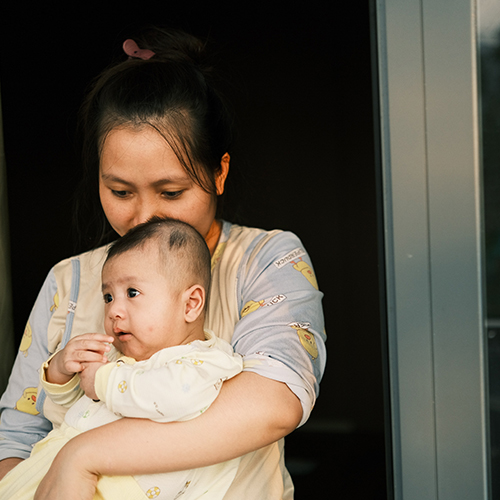Unequal paid work, unpaid domestic labor, and inadequate access to high quality childcare: Is this women’s economic empowerment?
Huilin Li, Katherine Hay, Jennifer Yore, Rebecca Levine, Anita Raj
The rate of labor force participation in California is stagnant, maintaining a 13% gender gap that disadvantages women. Correspondingly, women’s unemployment rate is also higher than that seen for men in the state, having worsened for females more than for males at the start of the pandemic, though the gender gap in unemployment has reduced slightly in the past year. Women who are married or parenting young children are even less likely than their male counterparts to be in the labor force. Personal costs relative to benefits for employment differ by gender.
Women make 89 cents to a man’s dollar, and if they are mothers, they are more likely than male partners to be managing childcare and family illness. The 8hr day/40 hour work week was a product of the industrial revolution (circa early to mid 1800s and then formally signed into law in 1940) – when a household’s head was comprised of a formally employed male and a stay at home wife (responsible for childcare, housekeeping, groceries/meals, errands, appointments, etc.). This and other social systems were designed around this division of paid and unpaid work, with few or inadequate changes – even as women increasingly joined the paid workforce. Families in California in particular, face poor access to high quality, affordable childcare, given that childcare costs in the State are among the most expensive in the nation.
The COVID-19 pandemic has only exacerbated this double burden – or the workload of people who work to earn money, but who are also responsible for large amounts of unpaid work in the home. California counties were among the hardest hit in child care closures, added parental teaching responsibilities, and increased stress and mental burden for employed mothers in particular.
The pandemic has surfaced the disempowering nature of women’s employment in a context of unequal pay, unequal household labor and childcare burdens, and unreasonable childcare costs relative to pay. For example, recent research from California shows that a typical childcare provider would have to spend more than half of her earnings to afford childcare. These impacts not only harm women – they harm children.
What COVID-19 Taught Us About Division of Labor
The Covid-19 shutdown disadvantaged women more than men. To mitigate the spread of the pandemic, like many other states, California enacted strict “stay at home” orders. Parents and children alike, and occasionally extended family members, were required to spend their days in the same household, which increased housework and other domestic demands for the family. Not surprisingly, due to traditional roles, social norms, and deep-rooted gender stereotypes, men and women reacted differently to the sudden increase of housework. Nationwide data shows that compared to working fathers, around three times more working mothers reported that they are the only provider of house work and child care. Although the “stay at home” order provided men a chance to spend more time as fathers to play and take care of children, this role is insignificant compared to the large amount of daily tasks taken on by mothers. In fact, increased cleaning and cooking demands that the “stay at home” mandate entailed heavily encroached on mothers’ leisure time, contributing to greater time poverty among women.
During the pandemic, in California, the wage gap between men and women in the same positions increased, especially for frontline workers. Maintaining this workforce with unequal and low pay, particularly in light of their having faced greater exposures to COVID-19 to maintain essential work, raises ethical issues. Even prior to the pandemic, care work often lacks benefits and protections, offers low wages or non-compensation, and increases exposure to abuses in the workplace. Women working in the care economy are more likely to be living in poverty and women of color, populations with higher rates of COVID-19 exposure and experiencing greater burden of COVID-19 care need in their own households. Despite their roles as caregivers to others’ children, women working in the care economy typically have their own children, for whom they are often primary caregivers.
Young Victims of the Domestic Gender Inequity
The pandemic impacts the mental health of mothers, also contributes to decreased wellbeing among children. Emerging research during COVID-19 indicates that mothers’ increased stress is having surprising and previously undiscovered effects on the wellbeing of children. Examples include:
- Food insecurity, stress, and non-responsive feeding practice. Working and taking care of children simultaneously put extra pressure on mothers to arrange their time. Economic impacts can also create food insecure households, compromising access to nutritious foods for growing children. At the same time, time constraints for stressed parents can result in inadequate monitoring of or mindful inputs into child feeding strategies, increasing reliance on more convenient and less nutritious foods. Further, use of food as a reward for children – a form of non-responsive feeding – increases children’s food interest and intake for reasons other than hunger.
- Child maltreatment. Emotional ups and downs caused by multiple stressors affected the way mothers interacted with their children. Although in California there was a drop in child protection reports, child abuse may have increased but gone unreported due to the the systems interruptions that typically identify these cases, such as schools and health services. Family stresses under COVID and consequent health and economic stressors can also increase child maltreatment, and under the isolation required by COVID the vulnerability of the child can go unchecked for longer periods. Mothers are more often the perpetrators of child abuse, due to gender roles and expectations of mothers for caregiving.
- The “collision of caregiver, playmate, and educator roles”. Research from international settings has shown that when schools and early care centers were closed, parents, and particularly mothers, had to extend their roles as parents to include being teachers and playmates. The result has been mixed with both reports of more quality time being spent but also increased screen time for children.
Implication for Policy and Practice
Although the pandemic is an unexpected global crisis with grave impacts, it also offers the opportunity to create systemic changes to improve the lives of women and children in our state, by strengthening child care systems in California. We recommend:
- More accessible & lower cost (or free) early childcare, especially during times of increased financial strain on families. For instance, the Crèche models that have been used in France, but also available to US military (but not US citizens) are a well tested option.
- Continuation of Child Tax Credit payments, granting families the ability to mitigate childcare costs in real time.
- Paid parental leave for both parents. The economic status for 70% of households with young children depends on mothers’ income, therefore, household economic insecurity contributes to an increase of burden on mothers. Paid parental leave policies that can encourage male partners to take leave can help support equality of care..
- Fair pay and good benefits for our care workers, including those working with infants and in early child education.
- Policies like the American Families Plan delivered in California; this plan would institute a national comprehensive paid family leave program, ensure universal childcare for 3 and 4 year olds, and build our teacher workforce.
- Universal before and aftercare for school-age children. The current lottery model means that places are not guaranteed.
- Increased number of on-site school-based health and wellness centers, to allow for greater time savings for parents for standard and acute pediatric care visits.
- Child and Elder Care sick days, to allow for parents to take sick leave to care for dependents and not lose their own sick days – which is simultaneously beneficial in that it helps prevent the spread of illness in daycare, school or work environments.
This pandemic is not passing quickly, but we can work now to pass the necessary policies to ensure economic and health security of our caregivers as well as our children long term. In doing so, we can begin to address long standing disparities experienced by women as employees, business owners, wives and mothers, to help create greater equity in the labor force. Supporting women and caregivers now will help to shift cultural and social norms, as children grow up observing new societal standards and expectations of support and investment in women.




